Report on Leadership and Management: Key Concepts and Analysis
VerifiedAdded on 2023/01/12
|15
|4926
|90
Report
AI Summary
This report delves into the multifaceted realm of leadership and management within organizations. It begins by differentiating between the roles of managers and leaders, emphasizing their distinct responsibilities in planning, organizing, motivating, and inspiring employees. The report reviews relevant literature, highlighting the similarities and differences between management and leadership, such as their shared goals of improving efficiency and creating a positive work environment, while contrasting their authorities and scopes. Various leadership theories are examined, including behavioral and transformational leadership, with their application in real-world scenarios. Furthermore, the report evaluates the NHS Leadership Development Programme, specifically the Elizabeth Garrett Anderson Leadership programme, assessing its effectiveness and the individual and organizational benefits derived from it. The analysis underscores the significance of leadership training and development for organizational success, providing valuable insights for aspiring leaders and managers.
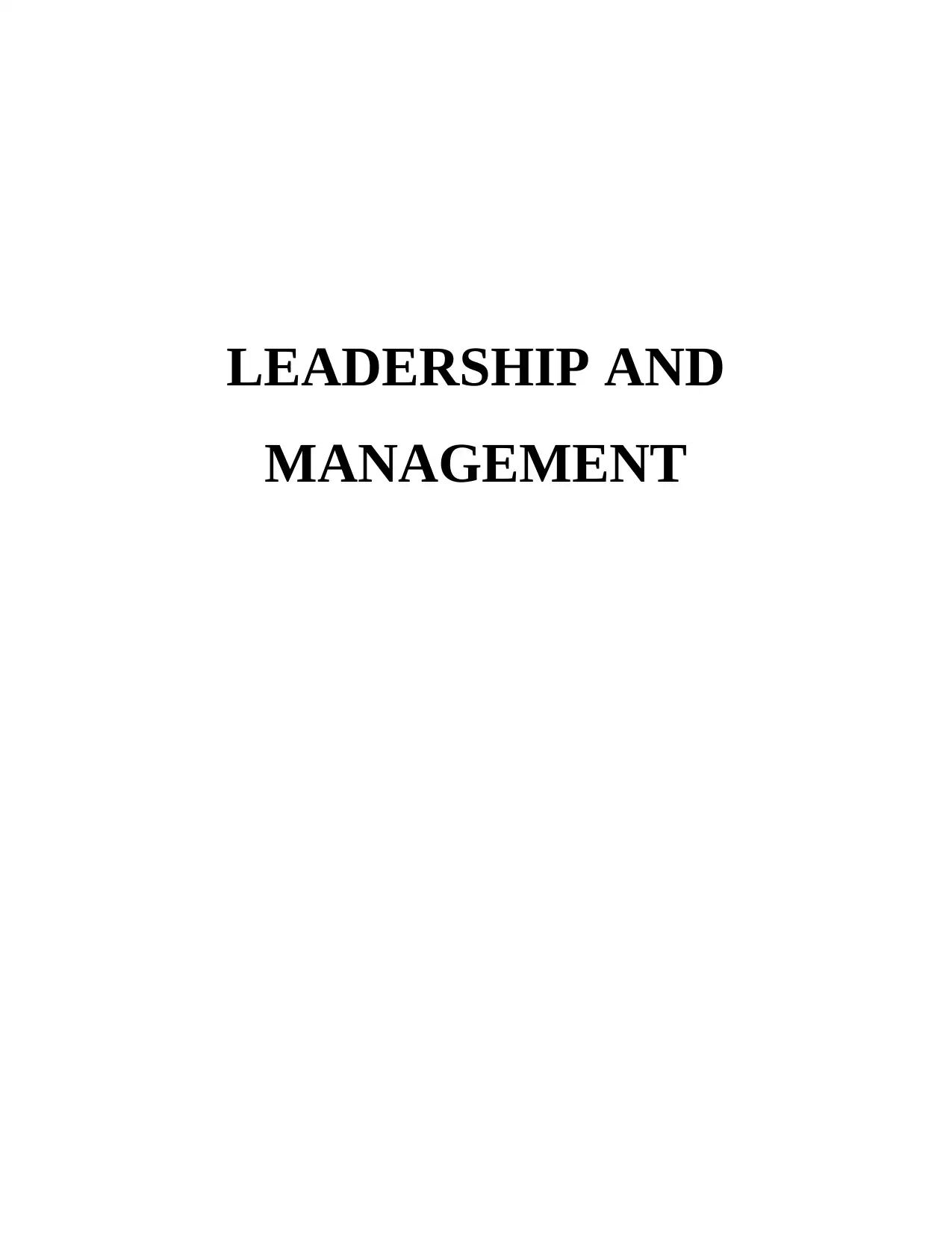
LEADERSHIP AND
MANAGEMENT
MANAGEMENT
Paraphrase This Document
Need a fresh take? Get an instant paraphrase of this document with our AI Paraphraser
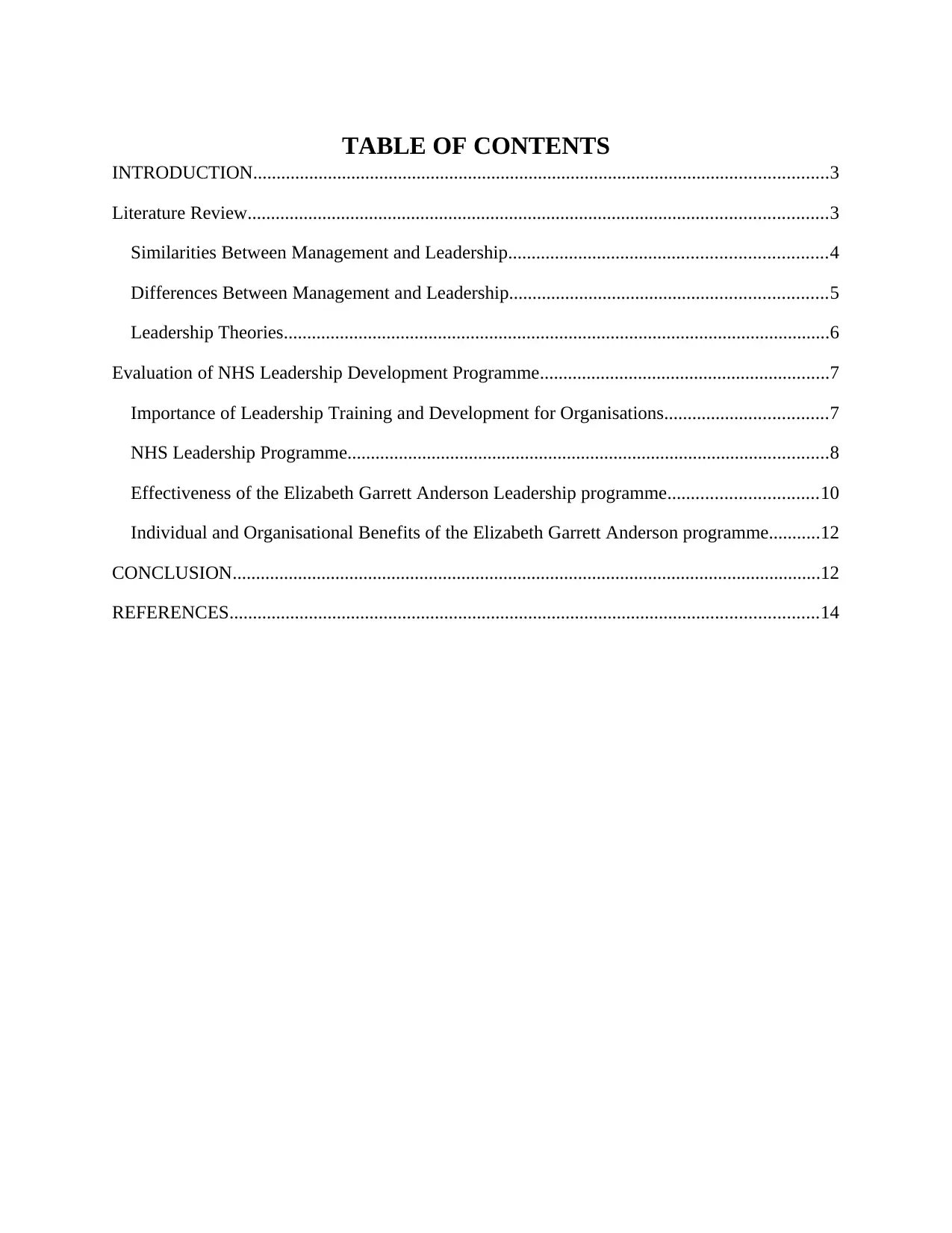
TABLE OF CONTENTS
INTRODUCTION...........................................................................................................................3
Literature Review............................................................................................................................3
Similarities Between Management and Leadership....................................................................4
Differences Between Management and Leadership....................................................................5
Leadership Theories.....................................................................................................................6
Evaluation of NHS Leadership Development Programme..............................................................7
Importance of Leadership Training and Development for Organisations...................................7
NHS Leadership Programme.......................................................................................................8
Effectiveness of the Elizabeth Garrett Anderson Leadership programme................................10
Individual and Organisational Benefits of the Elizabeth Garrett Anderson programme...........12
CONCLUSION..............................................................................................................................12
REFERENCES..............................................................................................................................14
INTRODUCTION...........................................................................................................................3
Literature Review............................................................................................................................3
Similarities Between Management and Leadership....................................................................4
Differences Between Management and Leadership....................................................................5
Leadership Theories.....................................................................................................................6
Evaluation of NHS Leadership Development Programme..............................................................7
Importance of Leadership Training and Development for Organisations...................................7
NHS Leadership Programme.......................................................................................................8
Effectiveness of the Elizabeth Garrett Anderson Leadership programme................................10
Individual and Organisational Benefits of the Elizabeth Garrett Anderson programme...........12
CONCLUSION..............................................................................................................................12
REFERENCES..............................................................................................................................14
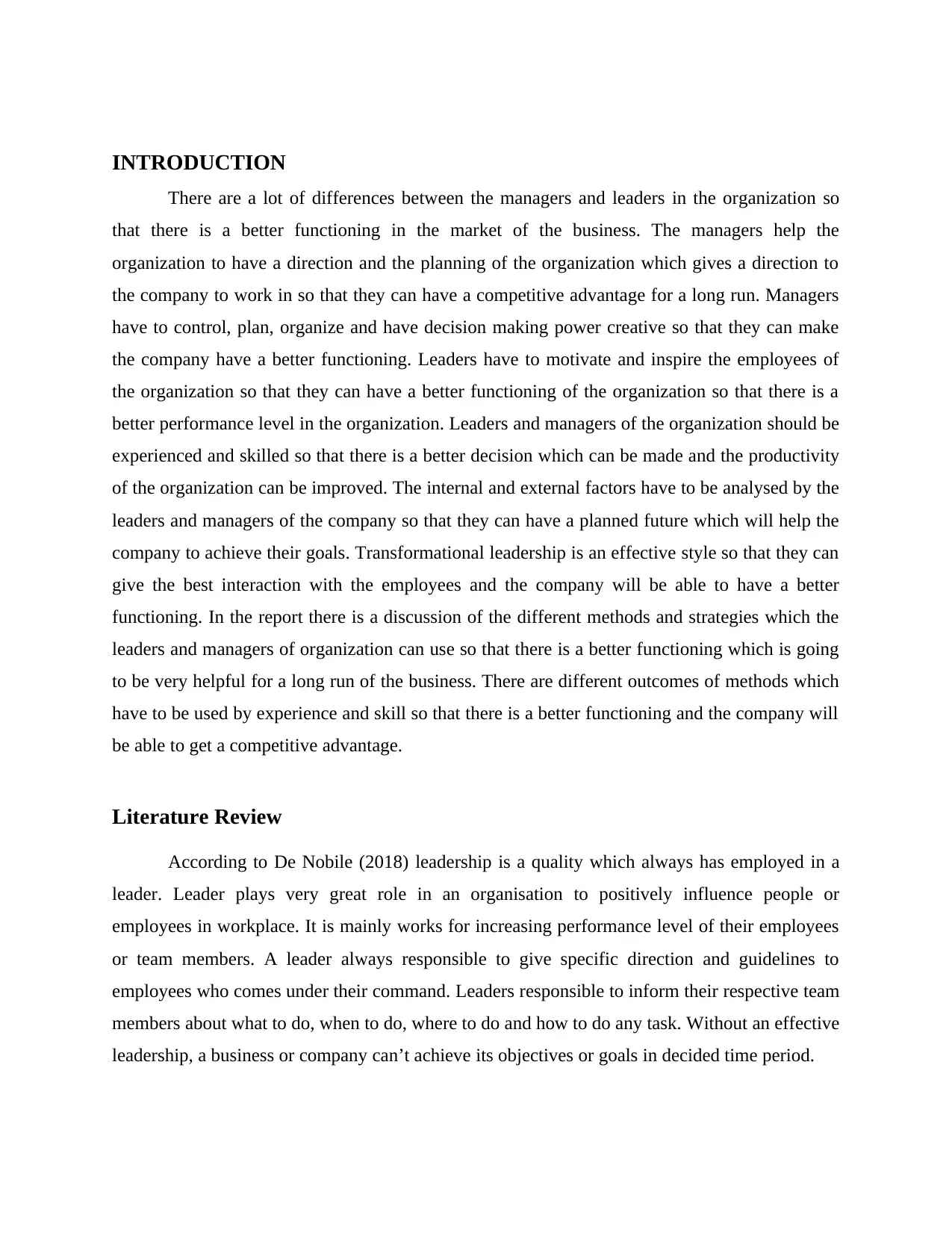
INTRODUCTION
There are a lot of differences between the managers and leaders in the organization so
that there is a better functioning in the market of the business. The managers help the
organization to have a direction and the planning of the organization which gives a direction to
the company to work in so that they can have a competitive advantage for a long run. Managers
have to control, plan, organize and have decision making power creative so that they can make
the company have a better functioning. Leaders have to motivate and inspire the employees of
the organization so that they can have a better functioning of the organization so that there is a
better performance level in the organization. Leaders and managers of the organization should be
experienced and skilled so that there is a better decision which can be made and the productivity
of the organization can be improved. The internal and external factors have to be analysed by the
leaders and managers of the company so that they can have a planned future which will help the
company to achieve their goals. Transformational leadership is an effective style so that they can
give the best interaction with the employees and the company will be able to have a better
functioning. In the report there is a discussion of the different methods and strategies which the
leaders and managers of organization can use so that there is a better functioning which is going
to be very helpful for a long run of the business. There are different outcomes of methods which
have to be used by experience and skill so that there is a better functioning and the company will
be able to get a competitive advantage.
Literature Review
According to De Nobile (2018) leadership is a quality which always has employed in a
leader. Leader plays very great role in an organisation to positively influence people or
employees in workplace. It is mainly works for increasing performance level of their employees
or team members. A leader always responsible to give specific direction and guidelines to
employees who comes under their command. Leaders responsible to inform their respective team
members about what to do, when to do, where to do and how to do any task. Without an effective
leadership, a business or company can’t achieve its objectives or goals in decided time period.
There are a lot of differences between the managers and leaders in the organization so
that there is a better functioning in the market of the business. The managers help the
organization to have a direction and the planning of the organization which gives a direction to
the company to work in so that they can have a competitive advantage for a long run. Managers
have to control, plan, organize and have decision making power creative so that they can make
the company have a better functioning. Leaders have to motivate and inspire the employees of
the organization so that they can have a better functioning of the organization so that there is a
better performance level in the organization. Leaders and managers of the organization should be
experienced and skilled so that there is a better decision which can be made and the productivity
of the organization can be improved. The internal and external factors have to be analysed by the
leaders and managers of the company so that they can have a planned future which will help the
company to achieve their goals. Transformational leadership is an effective style so that they can
give the best interaction with the employees and the company will be able to have a better
functioning. In the report there is a discussion of the different methods and strategies which the
leaders and managers of organization can use so that there is a better functioning which is going
to be very helpful for a long run of the business. There are different outcomes of methods which
have to be used by experience and skill so that there is a better functioning and the company will
be able to get a competitive advantage.
Literature Review
According to De Nobile (2018) leadership is a quality which always has employed in a
leader. Leader plays very great role in an organisation to positively influence people or
employees in workplace. It is mainly works for increasing performance level of their employees
or team members. A leader always responsible to give specific direction and guidelines to
employees who comes under their command. Leaders responsible to inform their respective team
members about what to do, when to do, where to do and how to do any task. Without an effective
leadership, a business or company can’t achieve its objectives or goals in decided time period.
⊘ This is a preview!⊘
Do you want full access?
Subscribe today to unlock all pages.

Trusted by 1+ million students worldwide
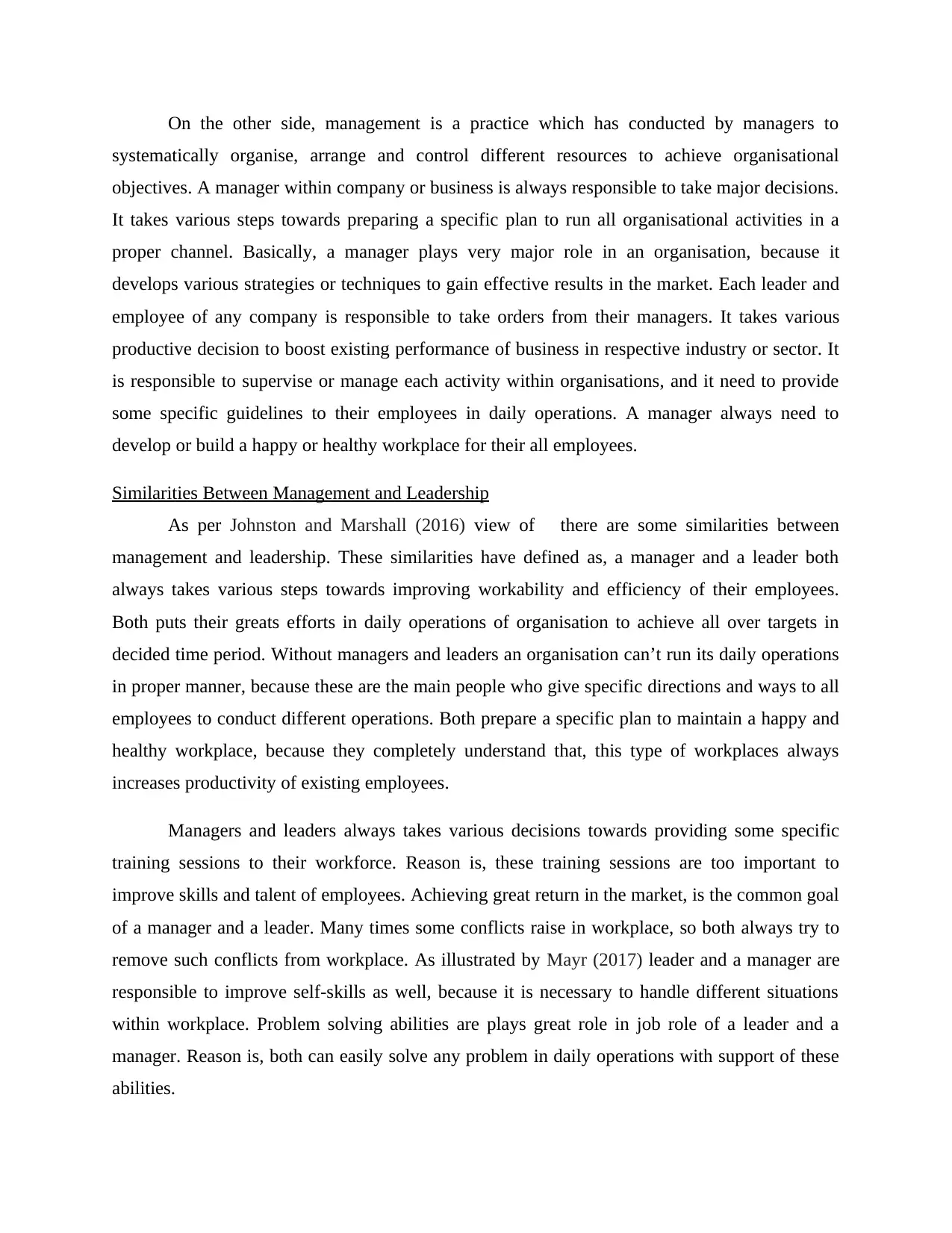
On the other side, management is a practice which has conducted by managers to
systematically organise, arrange and control different resources to achieve organisational
objectives. A manager within company or business is always responsible to take major decisions.
It takes various steps towards preparing a specific plan to run all organisational activities in a
proper channel. Basically, a manager plays very major role in an organisation, because it
develops various strategies or techniques to gain effective results in the market. Each leader and
employee of any company is responsible to take orders from their managers. It takes various
productive decision to boost existing performance of business in respective industry or sector. It
is responsible to supervise or manage each activity within organisations, and it need to provide
some specific guidelines to their employees in daily operations. A manager always need to
develop or build a happy or healthy workplace for their all employees.
Similarities Between Management and Leadership
As per Johnston and Marshall (2016) view of there are some similarities between
management and leadership. These similarities have defined as, a manager and a leader both
always takes various steps towards improving workability and efficiency of their employees.
Both puts their greats efforts in daily operations of organisation to achieve all over targets in
decided time period. Without managers and leaders an organisation can’t run its daily operations
in proper manner, because these are the main people who give specific directions and ways to all
employees to conduct different operations. Both prepare a specific plan to maintain a happy and
healthy workplace, because they completely understand that, this type of workplaces always
increases productivity of existing employees.
Managers and leaders always takes various decisions towards providing some specific
training sessions to their workforce. Reason is, these training sessions are too important to
improve skills and talent of employees. Achieving great return in the market, is the common goal
of a manager and a leader. Many times some conflicts raise in workplace, so both always try to
remove such conflicts from workplace. As illustrated by Mayr (2017) leader and a manager are
responsible to improve self-skills as well, because it is necessary to handle different situations
within workplace. Problem solving abilities are plays great role in job role of a leader and a
manager. Reason is, both can easily solve any problem in daily operations with support of these
abilities.
systematically organise, arrange and control different resources to achieve organisational
objectives. A manager within company or business is always responsible to take major decisions.
It takes various steps towards preparing a specific plan to run all organisational activities in a
proper channel. Basically, a manager plays very major role in an organisation, because it
develops various strategies or techniques to gain effective results in the market. Each leader and
employee of any company is responsible to take orders from their managers. It takes various
productive decision to boost existing performance of business in respective industry or sector. It
is responsible to supervise or manage each activity within organisations, and it need to provide
some specific guidelines to their employees in daily operations. A manager always need to
develop or build a happy or healthy workplace for their all employees.
Similarities Between Management and Leadership
As per Johnston and Marshall (2016) view of there are some similarities between
management and leadership. These similarities have defined as, a manager and a leader both
always takes various steps towards improving workability and efficiency of their employees.
Both puts their greats efforts in daily operations of organisation to achieve all over targets in
decided time period. Without managers and leaders an organisation can’t run its daily operations
in proper manner, because these are the main people who give specific directions and ways to all
employees to conduct different operations. Both prepare a specific plan to maintain a happy and
healthy workplace, because they completely understand that, this type of workplaces always
increases productivity of existing employees.
Managers and leaders always takes various decisions towards providing some specific
training sessions to their workforce. Reason is, these training sessions are too important to
improve skills and talent of employees. Achieving great return in the market, is the common goal
of a manager and a leader. Many times some conflicts raise in workplace, so both always try to
remove such conflicts from workplace. As illustrated by Mayr (2017) leader and a manager are
responsible to improve self-skills as well, because it is necessary to handle different situations
within workplace. Problem solving abilities are plays great role in job role of a leader and a
manager. Reason is, both can easily solve any problem in daily operations with support of these
abilities.
Paraphrase This Document
Need a fresh take? Get an instant paraphrase of this document with our AI Paraphraser
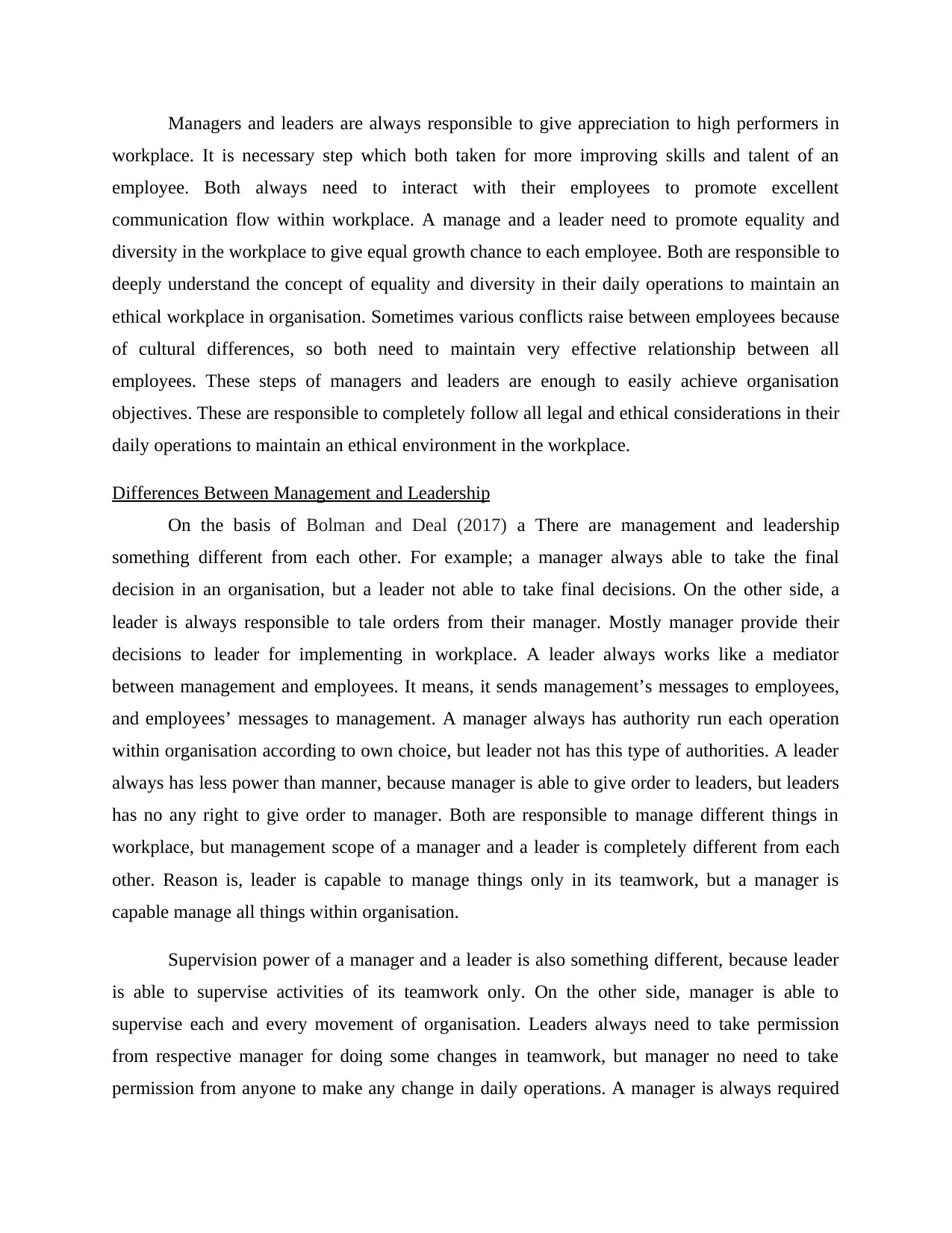
Managers and leaders are always responsible to give appreciation to high performers in
workplace. It is necessary step which both taken for more improving skills and talent of an
employee. Both always need to interact with their employees to promote excellent
communication flow within workplace. A manage and a leader need to promote equality and
diversity in the workplace to give equal growth chance to each employee. Both are responsible to
deeply understand the concept of equality and diversity in their daily operations to maintain an
ethical workplace in organisation. Sometimes various conflicts raise between employees because
of cultural differences, so both need to maintain very effective relationship between all
employees. These steps of managers and leaders are enough to easily achieve organisation
objectives. These are responsible to completely follow all legal and ethical considerations in their
daily operations to maintain an ethical environment in the workplace.
Differences Between Management and Leadership
On the basis of Bolman and Deal (2017) a There are management and leadership
something different from each other. For example; a manager always able to take the final
decision in an organisation, but a leader not able to take final decisions. On the other side, a
leader is always responsible to tale orders from their manager. Mostly manager provide their
decisions to leader for implementing in workplace. A leader always works like a mediator
between management and employees. It means, it sends management’s messages to employees,
and employees’ messages to management. A manager always has authority run each operation
within organisation according to own choice, but leader not has this type of authorities. A leader
always has less power than manner, because manager is able to give order to leaders, but leaders
has no any right to give order to manager. Both are responsible to manage different things in
workplace, but management scope of a manager and a leader is completely different from each
other. Reason is, leader is capable to manage things only in its teamwork, but a manager is
capable manage all things within organisation.
Supervision power of a manager and a leader is also something different, because leader
is able to supervise activities of its teamwork only. On the other side, manager is able to
supervise each and every movement of organisation. Leaders always need to take permission
from respective manager for doing some changes in teamwork, but manager no need to take
permission from anyone to make any change in daily operations. A manager is always required
workplace. It is necessary step which both taken for more improving skills and talent of an
employee. Both always need to interact with their employees to promote excellent
communication flow within workplace. A manage and a leader need to promote equality and
diversity in the workplace to give equal growth chance to each employee. Both are responsible to
deeply understand the concept of equality and diversity in their daily operations to maintain an
ethical workplace in organisation. Sometimes various conflicts raise between employees because
of cultural differences, so both need to maintain very effective relationship between all
employees. These steps of managers and leaders are enough to easily achieve organisation
objectives. These are responsible to completely follow all legal and ethical considerations in their
daily operations to maintain an ethical environment in the workplace.
Differences Between Management and Leadership
On the basis of Bolman and Deal (2017) a There are management and leadership
something different from each other. For example; a manager always able to take the final
decision in an organisation, but a leader not able to take final decisions. On the other side, a
leader is always responsible to tale orders from their manager. Mostly manager provide their
decisions to leader for implementing in workplace. A leader always works like a mediator
between management and employees. It means, it sends management’s messages to employees,
and employees’ messages to management. A manager always has authority run each operation
within organisation according to own choice, but leader not has this type of authorities. A leader
always has less power than manner, because manager is able to give order to leaders, but leaders
has no any right to give order to manager. Both are responsible to manage different things in
workplace, but management scope of a manager and a leader is completely different from each
other. Reason is, leader is capable to manage things only in its teamwork, but a manager is
capable manage all things within organisation.
Supervision power of a manager and a leader is also something different, because leader
is able to supervise activities of its teamwork only. On the other side, manager is able to
supervise each and every movement of organisation. Leaders always need to take permission
from respective manager for doing some changes in teamwork, but manager no need to take
permission from anyone to make any change in daily operations. A manager is always required
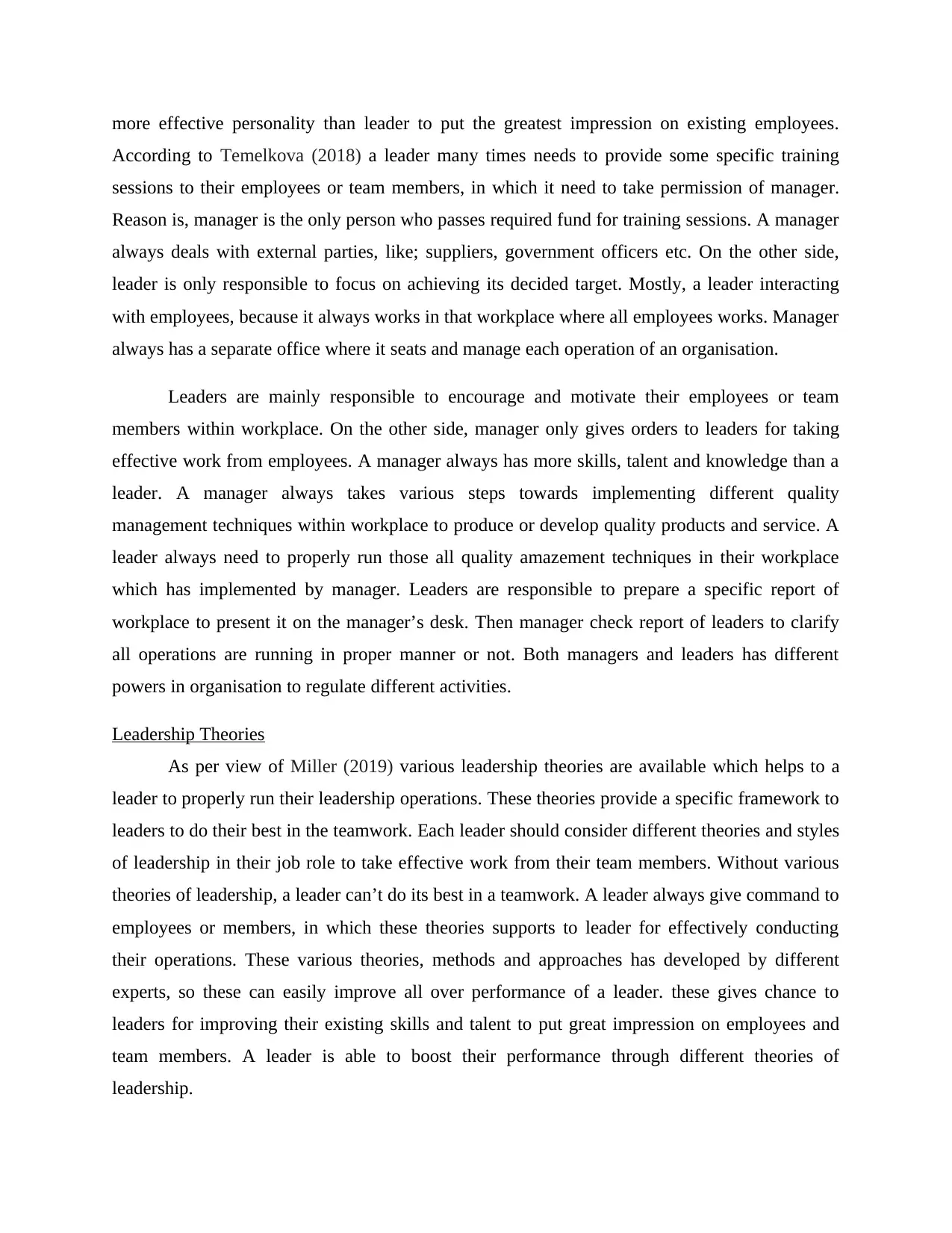
more effective personality than leader to put the greatest impression on existing employees.
According to Temelkova (2018) a leader many times needs to provide some specific training
sessions to their employees or team members, in which it need to take permission of manager.
Reason is, manager is the only person who passes required fund for training sessions. A manager
always deals with external parties, like; suppliers, government officers etc. On the other side,
leader is only responsible to focus on achieving its decided target. Mostly, a leader interacting
with employees, because it always works in that workplace where all employees works. Manager
always has a separate office where it seats and manage each operation of an organisation.
Leaders are mainly responsible to encourage and motivate their employees or team
members within workplace. On the other side, manager only gives orders to leaders for taking
effective work from employees. A manager always has more skills, talent and knowledge than a
leader. A manager always takes various steps towards implementing different quality
management techniques within workplace to produce or develop quality products and service. A
leader always need to properly run those all quality amazement techniques in their workplace
which has implemented by manager. Leaders are responsible to prepare a specific report of
workplace to present it on the manager’s desk. Then manager check report of leaders to clarify
all operations are running in proper manner or not. Both managers and leaders has different
powers in organisation to regulate different activities.
Leadership Theories
As per view of Miller (2019) various leadership theories are available which helps to a
leader to properly run their leadership operations. These theories provide a specific framework to
leaders to do their best in the teamwork. Each leader should consider different theories and styles
of leadership in their job role to take effective work from their team members. Without various
theories of leadership, a leader can’t do its best in a teamwork. A leader always give command to
employees or members, in which these theories supports to leader for effectively conducting
their operations. These various theories, methods and approaches has developed by different
experts, so these can easily improve all over performance of a leader. these gives chance to
leaders for improving their existing skills and talent to put great impression on employees and
team members. A leader is able to boost their performance through different theories of
leadership.
According to Temelkova (2018) a leader many times needs to provide some specific training
sessions to their employees or team members, in which it need to take permission of manager.
Reason is, manager is the only person who passes required fund for training sessions. A manager
always deals with external parties, like; suppliers, government officers etc. On the other side,
leader is only responsible to focus on achieving its decided target. Mostly, a leader interacting
with employees, because it always works in that workplace where all employees works. Manager
always has a separate office where it seats and manage each operation of an organisation.
Leaders are mainly responsible to encourage and motivate their employees or team
members within workplace. On the other side, manager only gives orders to leaders for taking
effective work from employees. A manager always has more skills, talent and knowledge than a
leader. A manager always takes various steps towards implementing different quality
management techniques within workplace to produce or develop quality products and service. A
leader always need to properly run those all quality amazement techniques in their workplace
which has implemented by manager. Leaders are responsible to prepare a specific report of
workplace to present it on the manager’s desk. Then manager check report of leaders to clarify
all operations are running in proper manner or not. Both managers and leaders has different
powers in organisation to regulate different activities.
Leadership Theories
As per view of Miller (2019) various leadership theories are available which helps to a
leader to properly run their leadership operations. These theories provide a specific framework to
leaders to do their best in the teamwork. Each leader should consider different theories and styles
of leadership in their job role to take effective work from their team members. Without various
theories of leadership, a leader can’t do its best in a teamwork. A leader always give command to
employees or members, in which these theories supports to leader for effectively conducting
their operations. These various theories, methods and approaches has developed by different
experts, so these can easily improve all over performance of a leader. these gives chance to
leaders for improving their existing skills and talent to put great impression on employees and
team members. A leader is able to boost their performance through different theories of
leadership.
⊘ This is a preview!⊘
Do you want full access?
Subscribe today to unlock all pages.

Trusted by 1+ million students worldwide
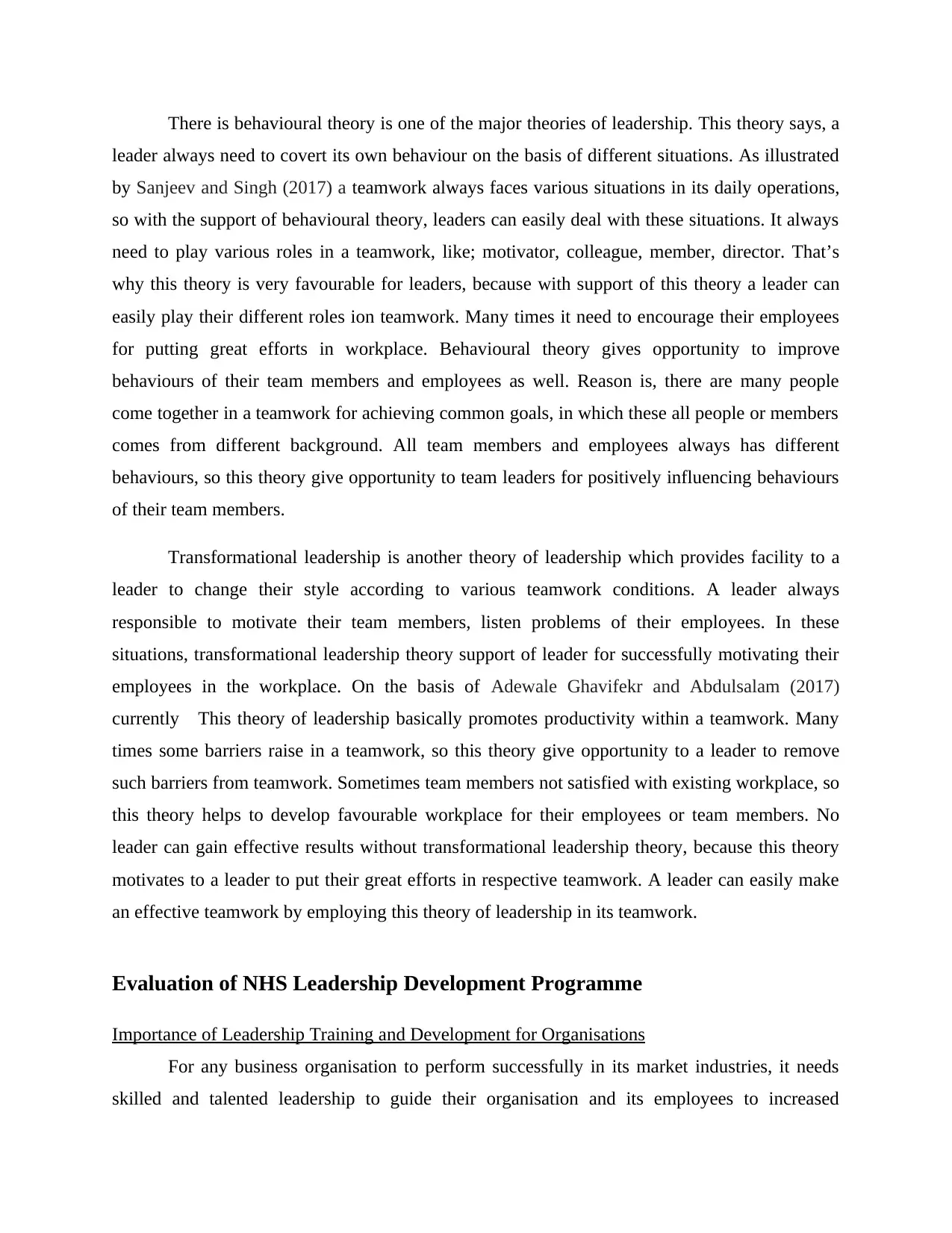
There is behavioural theory is one of the major theories of leadership. This theory says, a
leader always need to covert its own behaviour on the basis of different situations. As illustrated
by Sanjeev and Singh (2017) a teamwork always faces various situations in its daily operations,
so with the support of behavioural theory, leaders can easily deal with these situations. It always
need to play various roles in a teamwork, like; motivator, colleague, member, director. That’s
why this theory is very favourable for leaders, because with support of this theory a leader can
easily play their different roles ion teamwork. Many times it need to encourage their employees
for putting great efforts in workplace. Behavioural theory gives opportunity to improve
behaviours of their team members and employees as well. Reason is, there are many people
come together in a teamwork for achieving common goals, in which these all people or members
comes from different background. All team members and employees always has different
behaviours, so this theory give opportunity to team leaders for positively influencing behaviours
of their team members.
Transformational leadership is another theory of leadership which provides facility to a
leader to change their style according to various teamwork conditions. A leader always
responsible to motivate their team members, listen problems of their employees. In these
situations, transformational leadership theory support of leader for successfully motivating their
employees in the workplace. On the basis of Adewale Ghavifekr and Abdulsalam (2017)
currently This theory of leadership basically promotes productivity within a teamwork. Many
times some barriers raise in a teamwork, so this theory give opportunity to a leader to remove
such barriers from teamwork. Sometimes team members not satisfied with existing workplace, so
this theory helps to develop favourable workplace for their employees or team members. No
leader can gain effective results without transformational leadership theory, because this theory
motivates to a leader to put their great efforts in respective teamwork. A leader can easily make
an effective teamwork by employing this theory of leadership in its teamwork.
Evaluation of NHS Leadership Development Programme
Importance of Leadership Training and Development for Organisations
For any business organisation to perform successfully in its market industries, it needs
skilled and talented leadership to guide their organisation and its employees to increased
leader always need to covert its own behaviour on the basis of different situations. As illustrated
by Sanjeev and Singh (2017) a teamwork always faces various situations in its daily operations,
so with the support of behavioural theory, leaders can easily deal with these situations. It always
need to play various roles in a teamwork, like; motivator, colleague, member, director. That’s
why this theory is very favourable for leaders, because with support of this theory a leader can
easily play their different roles ion teamwork. Many times it need to encourage their employees
for putting great efforts in workplace. Behavioural theory gives opportunity to improve
behaviours of their team members and employees as well. Reason is, there are many people
come together in a teamwork for achieving common goals, in which these all people or members
comes from different background. All team members and employees always has different
behaviours, so this theory give opportunity to team leaders for positively influencing behaviours
of their team members.
Transformational leadership is another theory of leadership which provides facility to a
leader to change their style according to various teamwork conditions. A leader always
responsible to motivate their team members, listen problems of their employees. In these
situations, transformational leadership theory support of leader for successfully motivating their
employees in the workplace. On the basis of Adewale Ghavifekr and Abdulsalam (2017)
currently This theory of leadership basically promotes productivity within a teamwork. Many
times some barriers raise in a teamwork, so this theory give opportunity to a leader to remove
such barriers from teamwork. Sometimes team members not satisfied with existing workplace, so
this theory helps to develop favourable workplace for their employees or team members. No
leader can gain effective results without transformational leadership theory, because this theory
motivates to a leader to put their great efforts in respective teamwork. A leader can easily make
an effective teamwork by employing this theory of leadership in its teamwork.
Evaluation of NHS Leadership Development Programme
Importance of Leadership Training and Development for Organisations
For any business organisation to perform successfully in its market industries, it needs
skilled and talented leadership to guide their organisation and its employees to increased
Paraphrase This Document
Need a fresh take? Get an instant paraphrase of this document with our AI Paraphraser
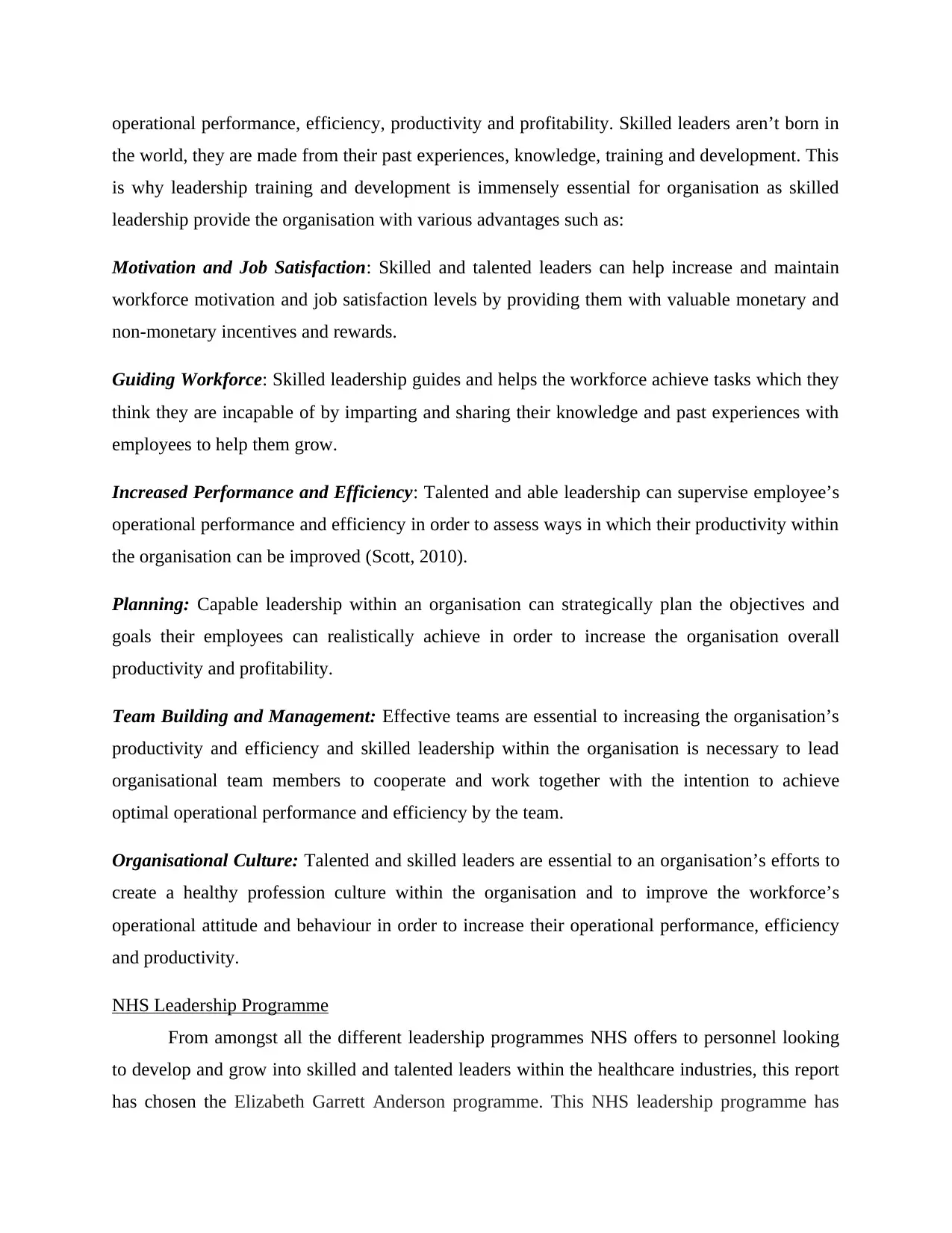
operational performance, efficiency, productivity and profitability. Skilled leaders aren’t born in
the world, they are made from their past experiences, knowledge, training and development. This
is why leadership training and development is immensely essential for organisation as skilled
leadership provide the organisation with various advantages such as:
Motivation and Job Satisfaction: Skilled and talented leaders can help increase and maintain
workforce motivation and job satisfaction levels by providing them with valuable monetary and
non-monetary incentives and rewards.
Guiding Workforce: Skilled leadership guides and helps the workforce achieve tasks which they
think they are incapable of by imparting and sharing their knowledge and past experiences with
employees to help them grow.
Increased Performance and Efficiency: Talented and able leadership can supervise employee’s
operational performance and efficiency in order to assess ways in which their productivity within
the organisation can be improved (Scott, 2010).
Planning: Capable leadership within an organisation can strategically plan the objectives and
goals their employees can realistically achieve in order to increase the organisation overall
productivity and profitability.
Team Building and Management: Effective teams are essential to increasing the organisation’s
productivity and efficiency and skilled leadership within the organisation is necessary to lead
organisational team members to cooperate and work together with the intention to achieve
optimal operational performance and efficiency by the team.
Organisational Culture: Talented and skilled leaders are essential to an organisation’s efforts to
create a healthy profession culture within the organisation and to improve the workforce’s
operational attitude and behaviour in order to increase their operational performance, efficiency
and productivity.
NHS Leadership Programme
From amongst all the different leadership programmes NHS offers to personnel looking
to develop and grow into skilled and talented leaders within the healthcare industries, this report
has chosen the Elizabeth Garrett Anderson programme. This NHS leadership programme has
the world, they are made from their past experiences, knowledge, training and development. This
is why leadership training and development is immensely essential for organisation as skilled
leadership provide the organisation with various advantages such as:
Motivation and Job Satisfaction: Skilled and talented leaders can help increase and maintain
workforce motivation and job satisfaction levels by providing them with valuable monetary and
non-monetary incentives and rewards.
Guiding Workforce: Skilled leadership guides and helps the workforce achieve tasks which they
think they are incapable of by imparting and sharing their knowledge and past experiences with
employees to help them grow.
Increased Performance and Efficiency: Talented and able leadership can supervise employee’s
operational performance and efficiency in order to assess ways in which their productivity within
the organisation can be improved (Scott, 2010).
Planning: Capable leadership within an organisation can strategically plan the objectives and
goals their employees can realistically achieve in order to increase the organisation overall
productivity and profitability.
Team Building and Management: Effective teams are essential to increasing the organisation’s
productivity and efficiency and skilled leadership within the organisation is necessary to lead
organisational team members to cooperate and work together with the intention to achieve
optimal operational performance and efficiency by the team.
Organisational Culture: Talented and skilled leaders are essential to an organisation’s efforts to
create a healthy profession culture within the organisation and to improve the workforce’s
operational attitude and behaviour in order to increase their operational performance, efficiency
and productivity.
NHS Leadership Programme
From amongst all the different leadership programmes NHS offers to personnel looking
to develop and grow into skilled and talented leaders within the healthcare industries, this report
has chosen the Elizabeth Garrett Anderson programme. This NHS leadership programme has
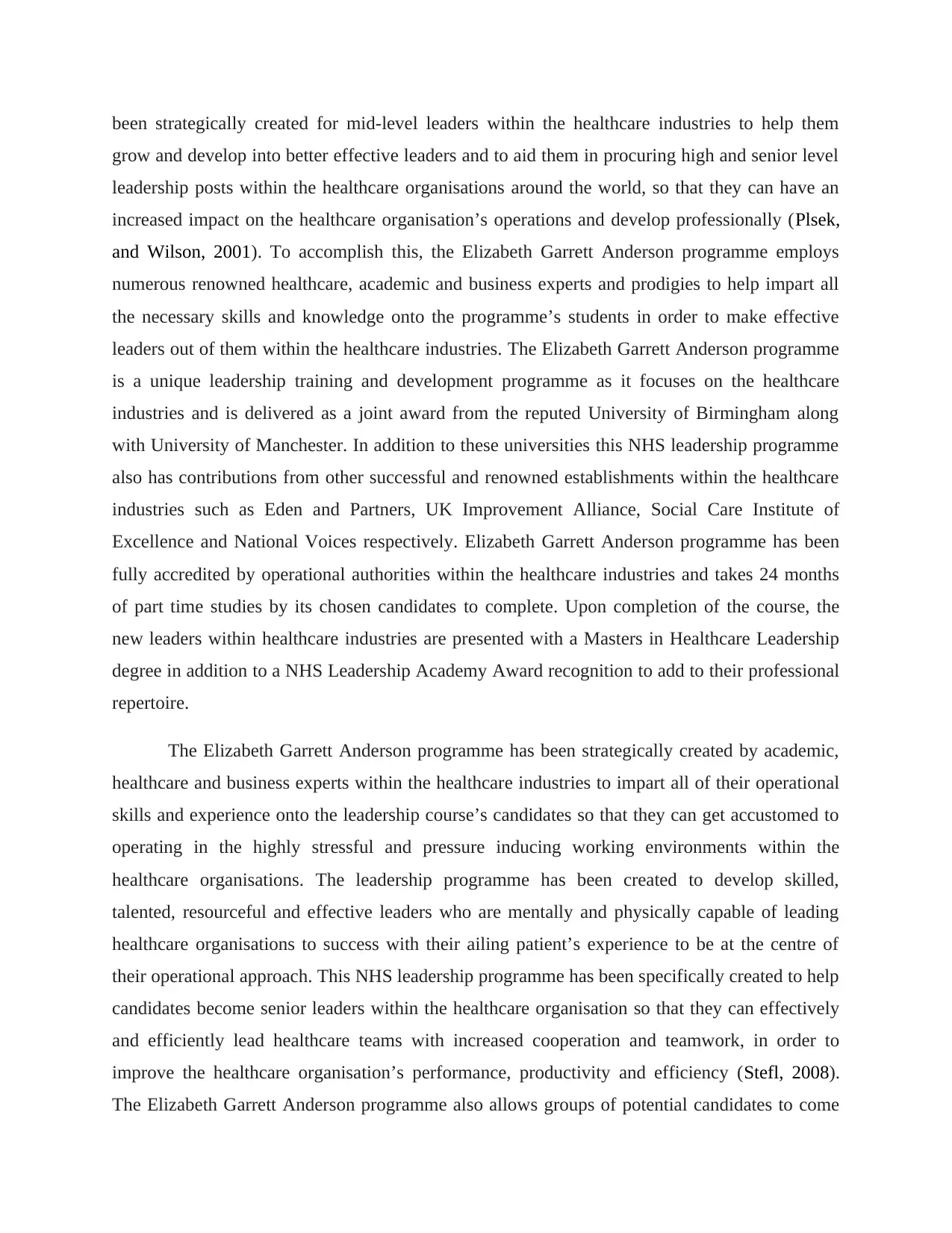
been strategically created for mid-level leaders within the healthcare industries to help them
grow and develop into better effective leaders and to aid them in procuring high and senior level
leadership posts within the healthcare organisations around the world, so that they can have an
increased impact on the healthcare organisation’s operations and develop professionally (Plsek,
and Wilson, 2001). To accomplish this, the Elizabeth Garrett Anderson programme employs
numerous renowned healthcare, academic and business experts and prodigies to help impart all
the necessary skills and knowledge onto the programme’s students in order to make effective
leaders out of them within the healthcare industries. The Elizabeth Garrett Anderson programme
is a unique leadership training and development programme as it focuses on the healthcare
industries and is delivered as a joint award from the reputed University of Birmingham along
with University of Manchester. In addition to these universities this NHS leadership programme
also has contributions from other successful and renowned establishments within the healthcare
industries such as Eden and Partners, UK Improvement Alliance, Social Care Institute of
Excellence and National Voices respectively. Elizabeth Garrett Anderson programme has been
fully accredited by operational authorities within the healthcare industries and takes 24 months
of part time studies by its chosen candidates to complete. Upon completion of the course, the
new leaders within healthcare industries are presented with a Masters in Healthcare Leadership
degree in addition to a NHS Leadership Academy Award recognition to add to their professional
repertoire.
The Elizabeth Garrett Anderson programme has been strategically created by academic,
healthcare and business experts within the healthcare industries to impart all of their operational
skills and experience onto the leadership course’s candidates so that they can get accustomed to
operating in the highly stressful and pressure inducing working environments within the
healthcare organisations. The leadership programme has been created to develop skilled,
talented, resourceful and effective leaders who are mentally and physically capable of leading
healthcare organisations to success with their ailing patient’s experience to be at the centre of
their operational approach. This NHS leadership programme has been specifically created to help
candidates become senior leaders within the healthcare organisation so that they can effectively
and efficiently lead healthcare teams with increased cooperation and teamwork, in order to
improve the healthcare organisation’s performance, productivity and efficiency (Stefl, 2008).
The Elizabeth Garrett Anderson programme also allows groups of potential candidates to come
grow and develop into better effective leaders and to aid them in procuring high and senior level
leadership posts within the healthcare organisations around the world, so that they can have an
increased impact on the healthcare organisation’s operations and develop professionally (Plsek,
and Wilson, 2001). To accomplish this, the Elizabeth Garrett Anderson programme employs
numerous renowned healthcare, academic and business experts and prodigies to help impart all
the necessary skills and knowledge onto the programme’s students in order to make effective
leaders out of them within the healthcare industries. The Elizabeth Garrett Anderson programme
is a unique leadership training and development programme as it focuses on the healthcare
industries and is delivered as a joint award from the reputed University of Birmingham along
with University of Manchester. In addition to these universities this NHS leadership programme
also has contributions from other successful and renowned establishments within the healthcare
industries such as Eden and Partners, UK Improvement Alliance, Social Care Institute of
Excellence and National Voices respectively. Elizabeth Garrett Anderson programme has been
fully accredited by operational authorities within the healthcare industries and takes 24 months
of part time studies by its chosen candidates to complete. Upon completion of the course, the
new leaders within healthcare industries are presented with a Masters in Healthcare Leadership
degree in addition to a NHS Leadership Academy Award recognition to add to their professional
repertoire.
The Elizabeth Garrett Anderson programme has been strategically created by academic,
healthcare and business experts within the healthcare industries to impart all of their operational
skills and experience onto the leadership course’s candidates so that they can get accustomed to
operating in the highly stressful and pressure inducing working environments within the
healthcare organisations. The leadership programme has been created to develop skilled,
talented, resourceful and effective leaders who are mentally and physically capable of leading
healthcare organisations to success with their ailing patient’s experience to be at the centre of
their operational approach. This NHS leadership programme has been specifically created to help
candidates become senior leaders within the healthcare organisation so that they can effectively
and efficiently lead healthcare teams with increased cooperation and teamwork, in order to
improve the healthcare organisation’s performance, productivity and efficiency (Stefl, 2008).
The Elizabeth Garrett Anderson programme also allows groups of potential candidates to come
⊘ This is a preview!⊘
Do you want full access?
Subscribe today to unlock all pages.

Trusted by 1+ million students worldwide
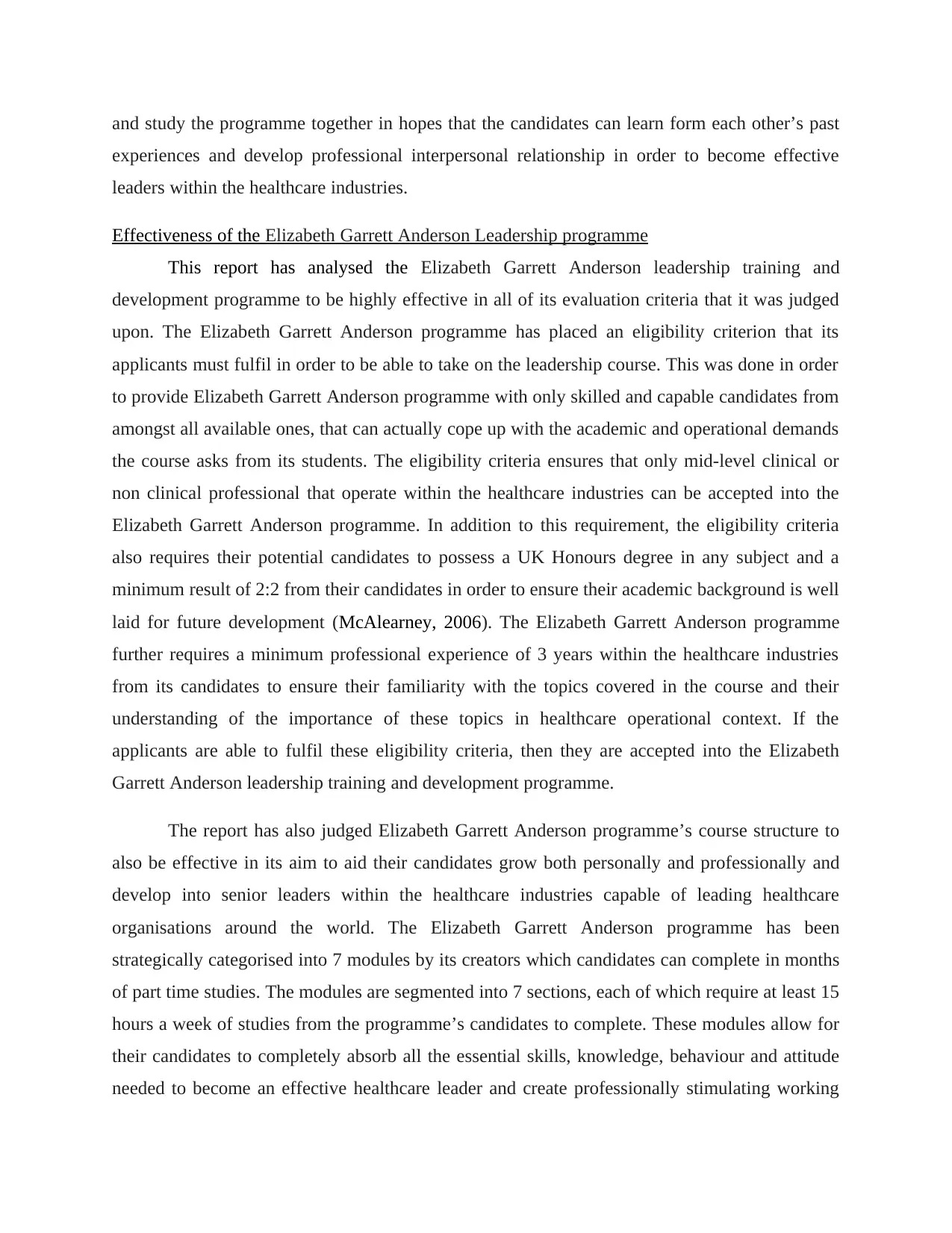
and study the programme together in hopes that the candidates can learn form each other’s past
experiences and develop professional interpersonal relationship in order to become effective
leaders within the healthcare industries.
Effectiveness of the Elizabeth Garrett Anderson Leadership programme
This report has analysed the Elizabeth Garrett Anderson leadership training and
development programme to be highly effective in all of its evaluation criteria that it was judged
upon. The Elizabeth Garrett Anderson programme has placed an eligibility criterion that its
applicants must fulfil in order to be able to take on the leadership course. This was done in order
to provide Elizabeth Garrett Anderson programme with only skilled and capable candidates from
amongst all available ones, that can actually cope up with the academic and operational demands
the course asks from its students. The eligibility criteria ensures that only mid-level clinical or
non clinical professional that operate within the healthcare industries can be accepted into the
Elizabeth Garrett Anderson programme. In addition to this requirement, the eligibility criteria
also requires their potential candidates to possess a UK Honours degree in any subject and a
minimum result of 2:2 from their candidates in order to ensure their academic background is well
laid for future development (McAlearney, 2006). The Elizabeth Garrett Anderson programme
further requires a minimum professional experience of 3 years within the healthcare industries
from its candidates to ensure their familiarity with the topics covered in the course and their
understanding of the importance of these topics in healthcare operational context. If the
applicants are able to fulfil these eligibility criteria, then they are accepted into the Elizabeth
Garrett Anderson leadership training and development programme.
The report has also judged Elizabeth Garrett Anderson programme’s course structure to
also be effective in its aim to aid their candidates grow both personally and professionally and
develop into senior leaders within the healthcare industries capable of leading healthcare
organisations around the world. The Elizabeth Garrett Anderson programme has been
strategically categorised into 7 modules by its creators which candidates can complete in months
of part time studies. The modules are segmented into 7 sections, each of which require at least 15
hours a week of studies from the programme’s candidates to complete. These modules allow for
their candidates to completely absorb all the essential skills, knowledge, behaviour and attitude
needed to become an effective healthcare leader and create professionally stimulating working
experiences and develop professional interpersonal relationship in order to become effective
leaders within the healthcare industries.
Effectiveness of the Elizabeth Garrett Anderson Leadership programme
This report has analysed the Elizabeth Garrett Anderson leadership training and
development programme to be highly effective in all of its evaluation criteria that it was judged
upon. The Elizabeth Garrett Anderson programme has placed an eligibility criterion that its
applicants must fulfil in order to be able to take on the leadership course. This was done in order
to provide Elizabeth Garrett Anderson programme with only skilled and capable candidates from
amongst all available ones, that can actually cope up with the academic and operational demands
the course asks from its students. The eligibility criteria ensures that only mid-level clinical or
non clinical professional that operate within the healthcare industries can be accepted into the
Elizabeth Garrett Anderson programme. In addition to this requirement, the eligibility criteria
also requires their potential candidates to possess a UK Honours degree in any subject and a
minimum result of 2:2 from their candidates in order to ensure their academic background is well
laid for future development (McAlearney, 2006). The Elizabeth Garrett Anderson programme
further requires a minimum professional experience of 3 years within the healthcare industries
from its candidates to ensure their familiarity with the topics covered in the course and their
understanding of the importance of these topics in healthcare operational context. If the
applicants are able to fulfil these eligibility criteria, then they are accepted into the Elizabeth
Garrett Anderson leadership training and development programme.
The report has also judged Elizabeth Garrett Anderson programme’s course structure to
also be effective in its aim to aid their candidates grow both personally and professionally and
develop into senior leaders within the healthcare industries capable of leading healthcare
organisations around the world. The Elizabeth Garrett Anderson programme has been
strategically categorised into 7 modules by its creators which candidates can complete in months
of part time studies. The modules are segmented into 7 sections, each of which require at least 15
hours a week of studies from the programme’s candidates to complete. These modules allow for
their candidates to completely absorb all the essential skills, knowledge, behaviour and attitude
needed to become an effective healthcare leader and create professionally stimulating working
Paraphrase This Document
Need a fresh take? Get an instant paraphrase of this document with our AI Paraphraser
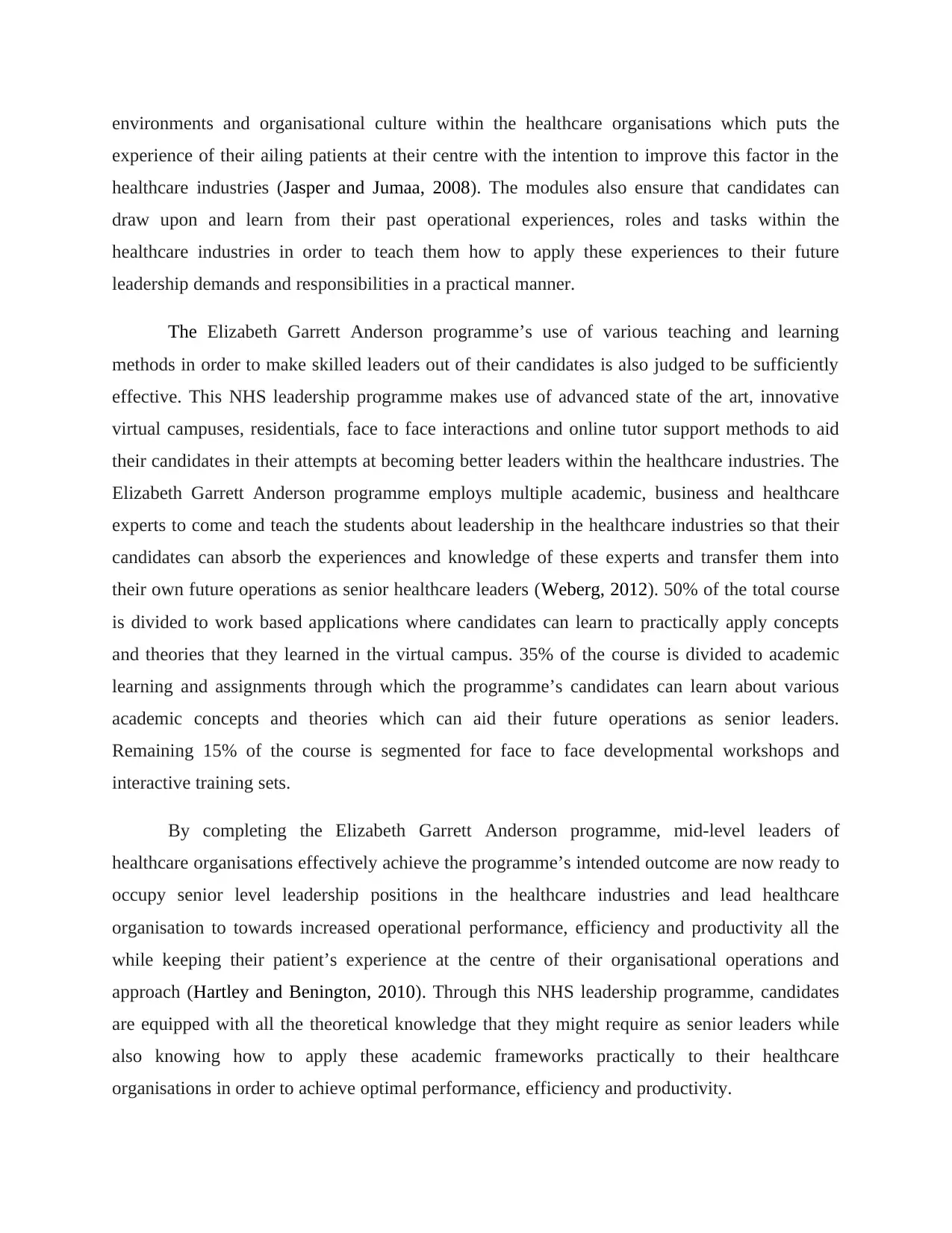
environments and organisational culture within the healthcare organisations which puts the
experience of their ailing patients at their centre with the intention to improve this factor in the
healthcare industries (Jasper and Jumaa, 2008). The modules also ensure that candidates can
draw upon and learn from their past operational experiences, roles and tasks within the
healthcare industries in order to teach them how to apply these experiences to their future
leadership demands and responsibilities in a practical manner.
The Elizabeth Garrett Anderson programme’s use of various teaching and learning
methods in order to make skilled leaders out of their candidates is also judged to be sufficiently
effective. This NHS leadership programme makes use of advanced state of the art, innovative
virtual campuses, residentials, face to face interactions and online tutor support methods to aid
their candidates in their attempts at becoming better leaders within the healthcare industries. The
Elizabeth Garrett Anderson programme employs multiple academic, business and healthcare
experts to come and teach the students about leadership in the healthcare industries so that their
candidates can absorb the experiences and knowledge of these experts and transfer them into
their own future operations as senior healthcare leaders (Weberg, 2012). 50% of the total course
is divided to work based applications where candidates can learn to practically apply concepts
and theories that they learned in the virtual campus. 35% of the course is divided to academic
learning and assignments through which the programme’s candidates can learn about various
academic concepts and theories which can aid their future operations as senior leaders.
Remaining 15% of the course is segmented for face to face developmental workshops and
interactive training sets.
By completing the Elizabeth Garrett Anderson programme, mid-level leaders of
healthcare organisations effectively achieve the programme’s intended outcome are now ready to
occupy senior level leadership positions in the healthcare industries and lead healthcare
organisation to towards increased operational performance, efficiency and productivity all the
while keeping their patient’s experience at the centre of their organisational operations and
approach (Hartley and Benington, 2010). Through this NHS leadership programme, candidates
are equipped with all the theoretical knowledge that they might require as senior leaders while
also knowing how to apply these academic frameworks practically to their healthcare
organisations in order to achieve optimal performance, efficiency and productivity.
experience of their ailing patients at their centre with the intention to improve this factor in the
healthcare industries (Jasper and Jumaa, 2008). The modules also ensure that candidates can
draw upon and learn from their past operational experiences, roles and tasks within the
healthcare industries in order to teach them how to apply these experiences to their future
leadership demands and responsibilities in a practical manner.
The Elizabeth Garrett Anderson programme’s use of various teaching and learning
methods in order to make skilled leaders out of their candidates is also judged to be sufficiently
effective. This NHS leadership programme makes use of advanced state of the art, innovative
virtual campuses, residentials, face to face interactions and online tutor support methods to aid
their candidates in their attempts at becoming better leaders within the healthcare industries. The
Elizabeth Garrett Anderson programme employs multiple academic, business and healthcare
experts to come and teach the students about leadership in the healthcare industries so that their
candidates can absorb the experiences and knowledge of these experts and transfer them into
their own future operations as senior healthcare leaders (Weberg, 2012). 50% of the total course
is divided to work based applications where candidates can learn to practically apply concepts
and theories that they learned in the virtual campus. 35% of the course is divided to academic
learning and assignments through which the programme’s candidates can learn about various
academic concepts and theories which can aid their future operations as senior leaders.
Remaining 15% of the course is segmented for face to face developmental workshops and
interactive training sets.
By completing the Elizabeth Garrett Anderson programme, mid-level leaders of
healthcare organisations effectively achieve the programme’s intended outcome are now ready to
occupy senior level leadership positions in the healthcare industries and lead healthcare
organisation to towards increased operational performance, efficiency and productivity all the
while keeping their patient’s experience at the centre of their organisational operations and
approach (Hartley and Benington, 2010). Through this NHS leadership programme, candidates
are equipped with all the theoretical knowledge that they might require as senior leaders while
also knowing how to apply these academic frameworks practically to their healthcare
organisations in order to achieve optimal performance, efficiency and productivity.
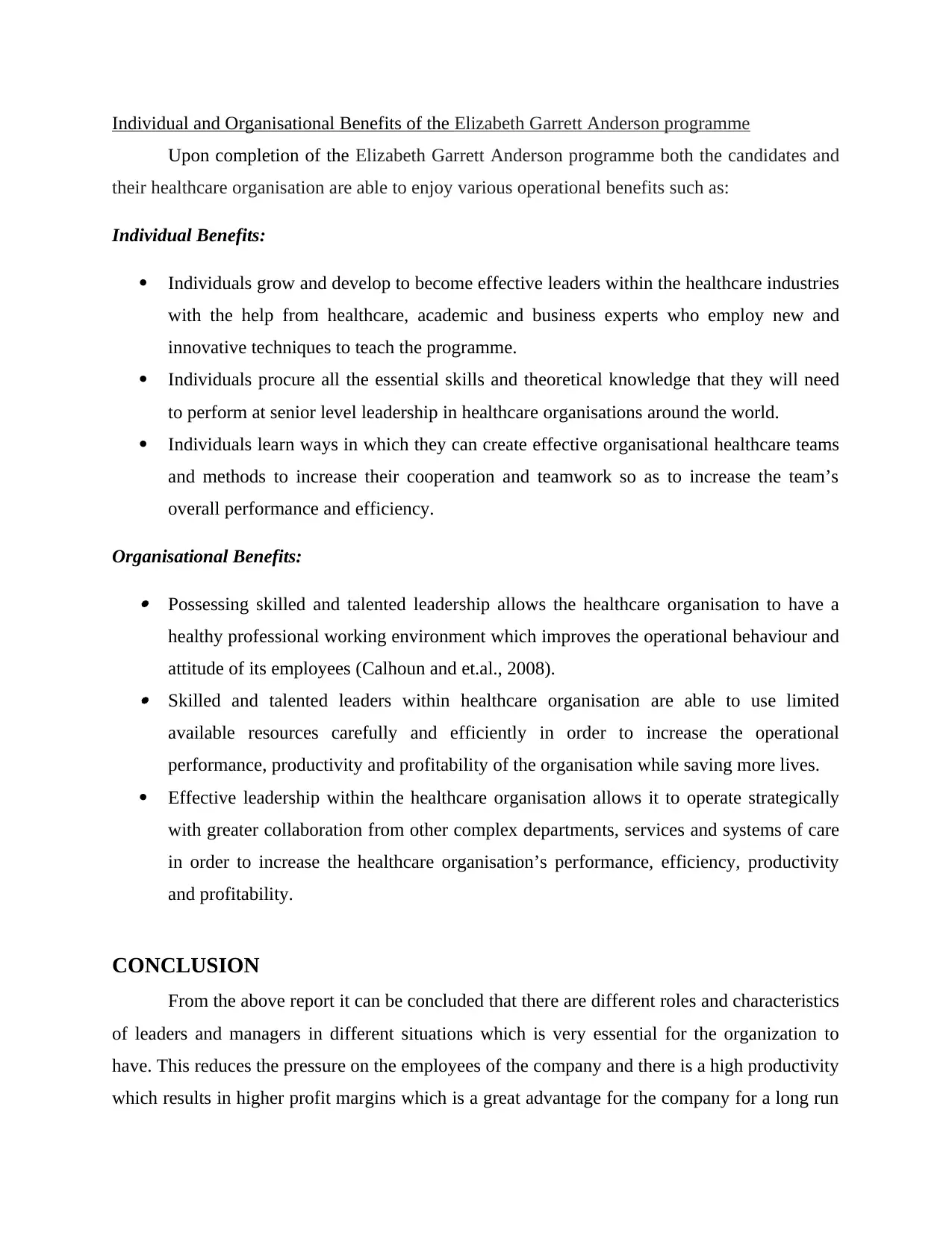
Individual and Organisational Benefits of the Elizabeth Garrett Anderson programme
Upon completion of the Elizabeth Garrett Anderson programme both the candidates and
their healthcare organisation are able to enjoy various operational benefits such as:
Individual Benefits:
Individuals grow and develop to become effective leaders within the healthcare industries
with the help from healthcare, academic and business experts who employ new and
innovative techniques to teach the programme.
Individuals procure all the essential skills and theoretical knowledge that they will need
to perform at senior level leadership in healthcare organisations around the world.
Individuals learn ways in which they can create effective organisational healthcare teams
and methods to increase their cooperation and teamwork so as to increase the team’s
overall performance and efficiency.
Organisational Benefits:
Possessing skilled and talented leadership allows the healthcare organisation to have a
healthy professional working environment which improves the operational behaviour and
attitude of its employees (Calhoun and et.al., 2008). Skilled and talented leaders within healthcare organisation are able to use limited
available resources carefully and efficiently in order to increase the operational
performance, productivity and profitability of the organisation while saving more lives.
Effective leadership within the healthcare organisation allows it to operate strategically
with greater collaboration from other complex departments, services and systems of care
in order to increase the healthcare organisation’s performance, efficiency, productivity
and profitability.
CONCLUSION
From the above report it can be concluded that there are different roles and characteristics
of leaders and managers in different situations which is very essential for the organization to
have. This reduces the pressure on the employees of the company and there is a high productivity
which results in higher profit margins which is a great advantage for the company for a long run
Upon completion of the Elizabeth Garrett Anderson programme both the candidates and
their healthcare organisation are able to enjoy various operational benefits such as:
Individual Benefits:
Individuals grow and develop to become effective leaders within the healthcare industries
with the help from healthcare, academic and business experts who employ new and
innovative techniques to teach the programme.
Individuals procure all the essential skills and theoretical knowledge that they will need
to perform at senior level leadership in healthcare organisations around the world.
Individuals learn ways in which they can create effective organisational healthcare teams
and methods to increase their cooperation and teamwork so as to increase the team’s
overall performance and efficiency.
Organisational Benefits:
Possessing skilled and talented leadership allows the healthcare organisation to have a
healthy professional working environment which improves the operational behaviour and
attitude of its employees (Calhoun and et.al., 2008). Skilled and talented leaders within healthcare organisation are able to use limited
available resources carefully and efficiently in order to increase the operational
performance, productivity and profitability of the organisation while saving more lives.
Effective leadership within the healthcare organisation allows it to operate strategically
with greater collaboration from other complex departments, services and systems of care
in order to increase the healthcare organisation’s performance, efficiency, productivity
and profitability.
CONCLUSION
From the above report it can be concluded that there are different roles and characteristics
of leaders and managers in different situations which is very essential for the organization to
have. This reduces the pressure on the employees of the company and there is a high productivity
which results in higher profit margins which is a great advantage for the company for a long run
⊘ This is a preview!⊘
Do you want full access?
Subscribe today to unlock all pages.

Trusted by 1+ million students worldwide
1 out of 15
Related Documents
Your All-in-One AI-Powered Toolkit for Academic Success.
+13062052269
info@desklib.com
Available 24*7 on WhatsApp / Email
![[object Object]](/_next/static/media/star-bottom.7253800d.svg)
Unlock your academic potential
Copyright © 2020–2025 A2Z Services. All Rights Reserved. Developed and managed by ZUCOL.





